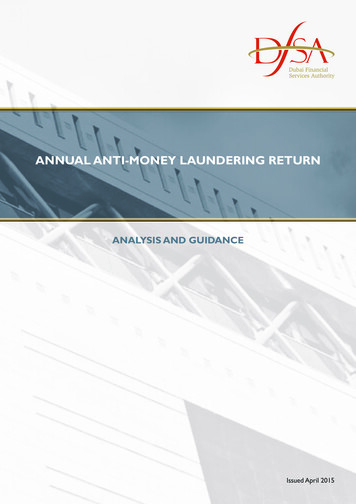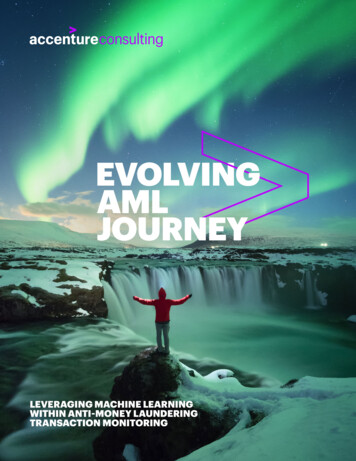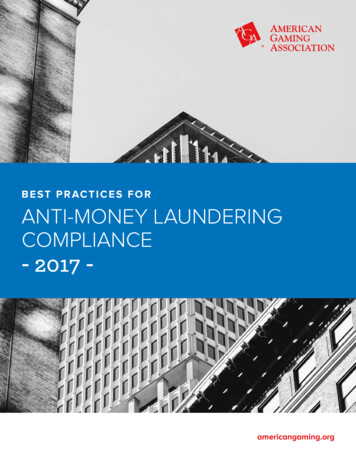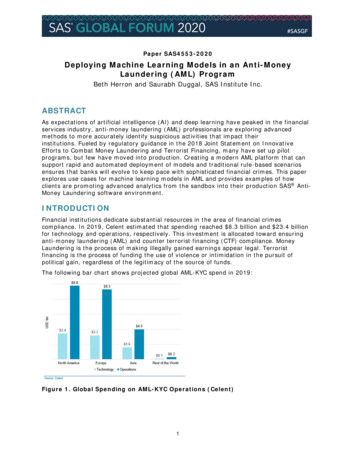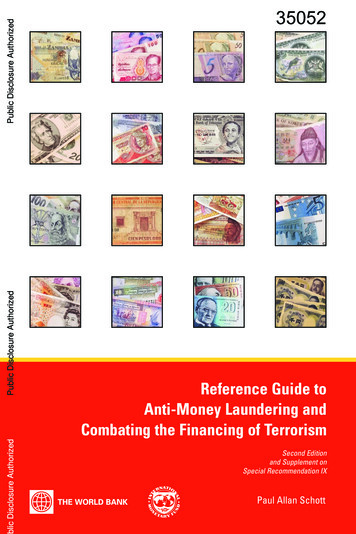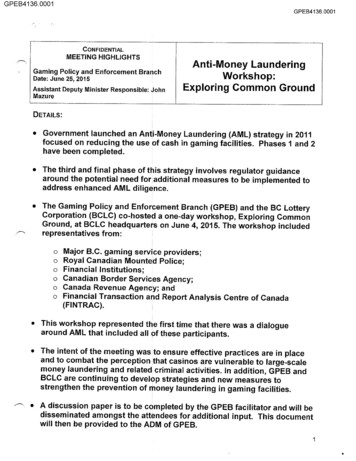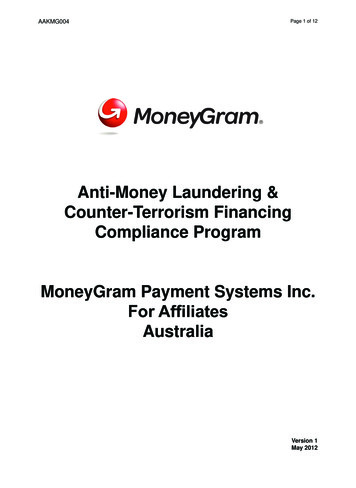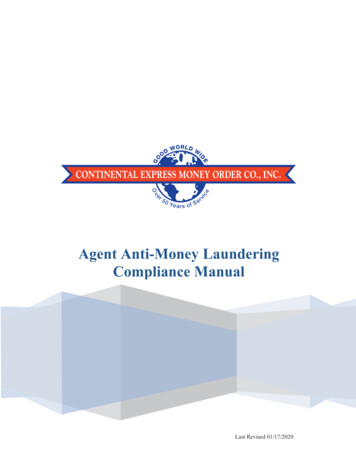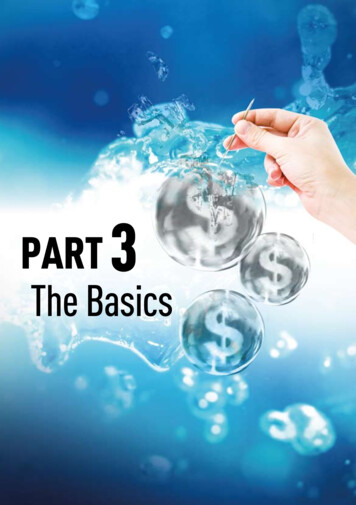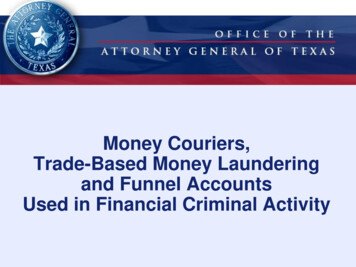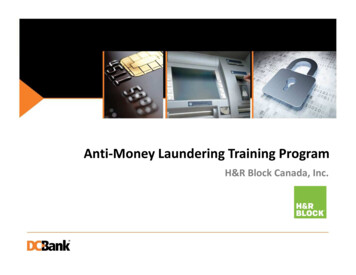
Transcription
Anti-Money Laundering Training ProgramH&R Block Canada, Inc.
ObjectivesDefine money laundering and terrorist financing.Identify Canadian government organizations involved in anti-money laundering(AML) and counter-terrorist financing (CTF).Identify the client requirements and records required to open a DC Bank account.Recognize and understand the importance of “Know Your Client” (KYC) rules.Recognize and identify suspicious transactions (attempted and completed).Understand the various penalties for non-compliance.2
About the Proceeds of Crime (Money Laundering) and Terrorist Financing ActThe objective of the Proceeds of Crime (Money Laundering) and Terrorist FinancingAct (PCMLTFA) is to help detect and deter money laundering and the financing ofterrorist activities.Your Responsibilities as an H&R Block Canada Inc. (H&R Block) associate:You must understand and implement requirements for: Record-keeping Client identification Reporting of suspicious transactionsYou must comply with the PCMLTFA and its supporting regulationsNon-compliance with the PCMLTFA can result in criminal charges or administrativefines.DC Bank’s Compliance Program establishes a mandate that H&R Block associates areable to demonstrate an understanding of money laundering and terrorist financingthrough the practice of their organization’s policies and procedures.3
Compliance RegimeDC Bank supports the fight against money laundering and terrorist financing and hasadopted a compliance regime to prevent its financial services from being used inpromoting criminal activity.DC Bank complies with all laws and regulations relating to money laundering andterrorist financing.Audits and reviews are conducted to ensure anti-money laundering (AML) andcounter-terrorist financing processes and documents are compliant and meetregulatory requirements.The DC Bank compliance regime includes:A compliance officer (DC Bank Compliance Department).Written and up-to-date AML/CTF policies and procedures.Risk assessment, as well as the documentation and implementation of mitigationmeasures to address risks.AML compliance training.Regular review all AML/CTF compliance policies and procedures.4
Government OrganizationsThere are two main Canadian Government organizations involved in detecting anddeterring money laundering and terrorist financing in Canada:FINTRAC – The Financial Transactions and Reports Analysis Centre of CanadaCanada’s financial intelligence unit (FIU) was created in 2000 as an independentagency reporting to the Minister of Finance. Its mission is to contribute to the publicsafety of Canadians and help protect the integrity of Canada’s financial systemthrough the detection and deterrence of money laundering and terrorist financing.FINTRAC ensures compliance of reporting entities with the legislation andregulations including record keeping and client identification requirements.OSFI – Office of the Superintendent of Financial InstitutionsCreated to contribute to public confidence in the Canadian financial system.OSFI performs regulatory audits on financial institutions.OSFI also requires that federally regulated financial institutions are compliant withtheir guidelines.5
AccountabilitiesCriminal Penalties include:Failure to report suspicious transactions or submit a terrorist property report: upto 2 million and/or 5 years imprisonment.Failure to meet record keeping requirements: up to 500,000 and/or 5 yearsimprisonment.Failure to provide assistance or provide information during a FINTRAC complianceexamination: up to 500,000 and/or 5 years imprisonment.Disclosing the fact that a suspicious transaction report was made (tipping off), ordisclosing the contents of such a report, with the intent to prejudice a criminalinvestigation: up to 2 years imprisonment.Civil Penalties: Each violation is classified as a minor, serious or very serious violation.The history of compliance by the associate with the PCMLTFA will be taken intoaccount in determining the amount of a penalty.Subject to the PCMLTFA, the range of penalties in respect of a violation is:(a) 1 to 1,000 in the case of a ‘minor’ violation;(b) 1 to 100,000 in the case of a ‘serious’ violation; and(c) 1 to 500,000 in the case of a ‘very serious’ violation.6
What is Money Laundering?Money laundering is the process of transforming the proceeds of crime (dirty money)into “clean” money or other assets. This is done by moving the money throughlegitimate businesses. Once complete, the money cannot be easily traced to its origin.Criminals may launder money to evade taxes that would be imposed on earnings,avoid seizure of their wealth and avoid prosecutionThe main categories of money launderers include:Organized Crime GroupsWhite Collar Professionals7
Three Stages of Money LaunderingPLACEMENT: The entry of illegal funds into the financial system to relievethe criminal of holding and guarding dirty money. Placement techniquesinclude structuring deposits in amounts to evade reporting requirementsor co-mingling currency deposits of legal and illegal enterprises.LAYERING: Hiding the origin of the funds through multiple and orcomplicated transactions. It is used to try and disguise any link with theoriginal crime that generated the dirty money.INTEGRATION: Exit of laundered funds from the financial system withoutattracting suspicion. The loading of illegal funds onto a prepaid card is anexample of integration.8
Three Stages of Money Laundering - ExamplesPLACEMENTH&R Block Canada has very little direct involvement with placement. A possible scenario is thecustomer requesting H&R Block make a Canada Revenue Agency payment, on their behalf, fortax owing via cash payment.LAYERINGIllegal income can be hidden at tax preparation time by declaring dirty money as cleanincome. This can be evident from suspicious types of income statements, fraudulent T-4slips or phony pay stubs. Other indicators can also include:Large declared income for an individual who cannot explain source of funds.Greater than normal number of income statements provided for the statedoccupation.Sizeable income reported from tax haven countries.INTEGRATIONTax refunds could be viewed as receiving legitimate funds from the process oflaundering dirty income or taking advantage of illegal deductions. Suspicion of tax fraudshould be reported, this is why it is important to pay close attention to thedocumentation used to prepare the customer’s tax return.9
What is Terrorist Financing?Terrorist financing (proceeds for crime) is the process by whichfunds are provided for terrorist activity.Large amount of funding for terrorism activities comes fromlegitimate sources, this is why terrorist financing is sometimesdepicted as the reverse of money laundering.Terrorist financing involves moving legitimate funds intoterrorist hands.Terrorist groups are monitored by OSFI (Canada) and theUnited Nations. Terrorist names are posted publically on theirrespective websites. DC Bank regularly consults these lists.10Reporting suspiciousbehavior is veryimportant, regardlessof if it is for moneylaundering orterrorist financing
Know Your ClientIn taking proactive measures to prevent money laundering or terrorist financing, it isimportant to ensure information obtained from required identification documents,reports and records is as accurate and effective as possible.The Know Your Client (KYC) Policy refers to the documentation which sets out DC Bank’sapproach to ensure effective identification, verification and monitoring of clients.The Principal Objectives of a KYC Policy include:1. Ensuring that only legitimate clients are provided with DC Bank products.2. Verifying the identity of clients through approved, reliable, and independentdocumentation.3. Ensuring that the risks posed by each client are understood.4. Managing the risks posed by identifying the source of funds, occupation, intendeduse of account, or suspicious behavior and transactions.11
Know Your Client (KYC) Policy ElementsAcceptanceThe point at which a new client is accepted or rejected is the easiest pointat which the risk of dealing with illegal money can be avoided.IdentificationEstablishing the identity of clients is the easiest way to help protect H&RBlock and DC Bank from unknowingly doing business with a terrorist orcriminal.VerificationVerify that clients are who they say they are by verifying originalgovernment issued Identification or an original identification documentfrom a primary or secondary form of ID in the Acceptable ID Policy.BehaviourIdentify and report any suspicious behavior or unusual activities.RiskKnow where the money came from (source of funds).12
Identifying Your Client – Proper IDIdentification of an individual is required at the time the account is being opened.1. Identifying your Client:Verify the clients identity by collecting two pieces of personal identification. At leastone must be from the Primary Identification List. It is preferred that the secondpiece be government issued identification also.ID must:Be in the same name and image as the applicant.Not be expired.Have a unique identifier.Be an original; NO photo copies.Not be substantially damaged or appear to be altered.13If the client cannotprovide ID, an accountcannot be opened
Identifying Your Client – Third Party Accounts2. Ensure client is NOT a third partyAlways ask the client if they are opening an account for themselves or on behalf ofsomeone else (Third Party).What is a Third Party?A Third Party is an individual or entity, other than the account holder who directswhat happens with the account.If only one individual is present but that person is acting on someone else’sinstructions, there is a third party involved.Note: A person conducting a transaction on behalf of an elderly or disabled personis considered to be a third party.DC Bank does not accept Third Party accounts; If you determine this is a ThirdParty account DO NOT OPEN THE ACCOUNT.14
Identifying Your Client – PEFPs and PEPs3. Ensure client is not a Politically Exposed Foreign Person (PEFP) or a PoliticallyExposed Person (domestic) PEP.A PEFP or PEP is defined as a person who holds or has held one of the followingoffices or positions in or on behalf of a foreign country or domestically:Head of state of governmentMember of the executive council of government or member of a legislatureDeputy minister or equivalent riskAmbassador or an ambassador’s attaché or counsellorA military general (or higher rank)President of a state-owned company or a state-owned bankHead of a government agencyA JudgeLeader of president of a political party represented in a legislatureA prescribed family member of a person listed aboveDue to their political position, these individuals may be susceptible to corruptionand/or bribery.15
Identifying Your Client – PEFPs and PEPs con’tYou must take reasonable measures to determine if the client is a PEFP or PEP andcheck the correct box on the Deposit Account Agreement. You must read the PEFP orPEP description to the customer or give the customer the Deposit AccountAgreement to read the description and then ask the customer directly, “Does thisdescription apply to you?”If the client says “Yes” they are a PEFP/PEP, record the information but DO NOT OPENTHE ACCOUNTDC Bank does not accept PEFPs or Domestic PEPs16
Identifying Your Client – OccupationOccupational Information:You are required to ask where an applicant works and his/her occupation or principalbusiness and then choose the corresponding occupation from the drop-down menu.If the drop down menu option does not specifically describe the occupation, choose onethat best applies and then manually write additional information on the DC BankAgreement form.It is a requirement that occupation information be as descriptive and specific as possible.For example, “contractor”, “owner”, “self-employed” are not specific enough as they donot indicate the type of business the client is in. If the customer is retired, the customer’sprevious occupation such as “retired teacher”, “retired book keeper on CPP”;“unemployed on social assistance”, or “unemployed on disability pension”, etc., shouldbe written on the form.The field “occupation” is very important because it assists in determining source ofincome.17
Completing an ApplicationIf a client refuses to provide all information required, a bank account CANNOT beopened. An associate CANNOT issue a prepaid card, load a card or process anytransaction without the client providing all information required.Place a copy of the signed Agreement/Terms and Conditions in a separate file andstore in a secure environment. All records must be kept in this file. Files must bekept for a minimum of seven years.Please ensure that the customer receives a copy of the Agreement/Terms andConditions.If proper identification information is not collected and recorded, large fines canbe levied against H&R Block, you personally as an H&R Block associate, and/or DCBank.18
Suspicious ActivityThere are two types of suspicious transactions:A completed suspicious transaction: a transaction that has occurred and is finalizedA suspicious attempted transaction: an incomplete transaction where after theprocess was started the DC Bank employee or H&R Block associate decides to cancelfor a specific reason.Both suspicious transactions and suspicious attempted transactions must bereported and escalated to your compliance department. Failure to report asuspicious transaction when you have reasonable grounds may result in criminalpenalties or fines to H&R Block, you personally as an H&R Block associate and/or guide2/2-eng.asp#s719
Examples of Suspicious ActivityFINTRAC has provided a list of suspicious transaction common indicators. Theseindicators include:Client admits or makes statements about involvement in criminal activities.Client is accompanied and watched.Client uses aliases and a variety of similar but different addresses.Client indicates he/she has been to two or more locations on the same day.Client states he/she does not have a local address but you suspect they residelocally.Client tries to use a post office box or General Delivery address or other type ofmail drop address instead of a street address when this is not the norm for thatarea.A client starts the process for a Pay With Refund but then leaves the branch whenasked for identification.Client provides false information or information that you believe is unreliable.Stated occupation of the client or the client’s financial standing is not in keepingwith the level or type of activity (for example a student or an unemployedindividual who undertakes a large-value transaction).20
Suspicious Transactions: Things to RememberWhen reporting a suspicious transaction (completed or attempted) or consideringmaking a report to the Compliance Department remember the following:The more information you know about your customer, the better position you will bein to determine whether the transaction is suspicious.To report a suspected suspicious or attempted suspicious transaction, the SuspiciousTransaction Form must be immediately emailed to the H&R Block ComplianceDepartment at:complianceAML@hrblock.ca21
Where is the Form Located?Path: CONTACT/Financial Services/Pay with Refund/Collateral Forms/Operational22
Tax EvasionTax evasion is the term for the illegal nonpayment or underpayment oftax.On July 12, 2010 tax evasion became a money laundering offence;because of this change you must now report any suspicious activity thatindicates your client may be involved in tax evasion.Indicators of tax evasion include:Transfer of large sums of money to foreign/low tax jurisdictions.Transactions involving a country known for highly secretive bankingand corporate law.Client and other parties to the transaction have no apparent ties toCanada.Client makes reference to transactions as ones being taken to tryand avoid taxes.Tax avoidance is the legal usage of the tax regime in a single territory toone's own advantage to reduce the amount of tax that is payable bymeans that are within the law. As tax avoidance is legal, it does notneed to be reported as suspicious.23
Reminder: Tipping OffFINTRAC Guideline 2, Suspicious Transactions: states, You are not allowed to informanyone, including the client, about the contents of a suspicious transaction report oreven that you have made such a report, if your intent is to harm or impair a criminalinvestigation. This applies whether or not such an investigation has begun.Because it is important not to tip your client off that youare making a suspicious transaction report, you shouldnot be requesting information from the individualconducting or attempting the transaction that youwould not normally request during a transaction.FINTRAC imposes monetary penalties on those who tip off anyone about a suspicioustransaction report if the intent is to harm or impair a criminal investigation.NOTE: By reporting to FINTRAC, no criminal or civil proceedings may be brought againstyou for making a report in good faith.24
Exercise – Suspicious TransactionsScenario:A new client meets with you to have a tax return prepared. This client is not aregular and you do not recognize him. You note the following things:The client is abrupt and irritable and is overly impatient to have the processcompleted, collect the ‘possible’ refund, and leave.During the review of the customer’s tax documents, it is noted the individual hasgenerated a lot of revenue during the year and some of this revenue was generatedinternationally.When asked what the customer does for a living, the customer states they are a selfemployed consultant, providing no further information while citing privacyregulations.When asked for clarification on certain documents, the explanations do not alwaysmake sense.Hand written invoices and questionable supply and deduction receipts are submitted.The customer appears overly thrilled with receiving a small return and is anxious toleave.Can you spot the suspicious indicators?25
Exercise – Suspicious Transactions, IndicatorsIn this situation, the indicators of suspicious activity include:The customer’s demeanor suggests their guard is up and that they might be hidingsomething.Some income statements provided were from international sources.Customer provided limited information regarding their employment.Customer puts up privacy regulatory walls to keep you in the darkSome of the documentation appears questionable.The customer is vague in explaining the relevance of certain documents.The customer’s final response after receiving a return does not fit with the situation andthe customer’s behavior through the tax preparation process.Remember: Any one indicator may not be suspicious, but you should consider allindicators and the entire situation when considering if there are reasonable grounds tosuspect the client may be involved in a suspicious transaction like tax evasion. If you doconclude that the transaction is suspicious, you should contact the H&R BlockCompliance Department as soon as possible at:complianceAML@hrblock.ca26
Questions?Please contact the compliance department at:ComplianceAML@hrblock.ca27
What is Money Laundering? Money laundering is the process of transforming the proceeds of crime (dirty money) into "clean" money or other assets. This is done by moving the money through legitimate businesses. Once complete, the money cannot be easily traced to its origin. Criminals may launder money to evade taxes that would be imposed on .
